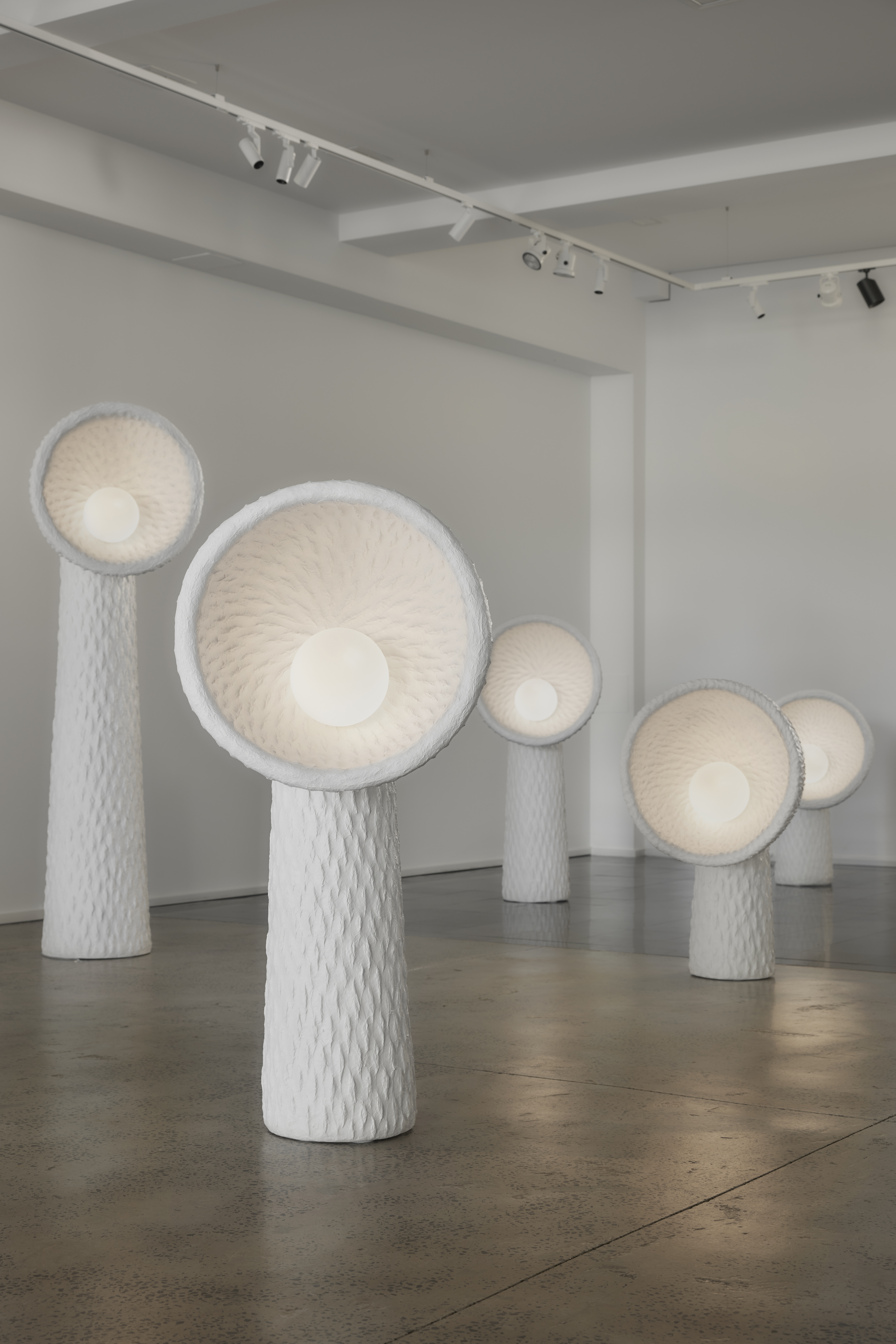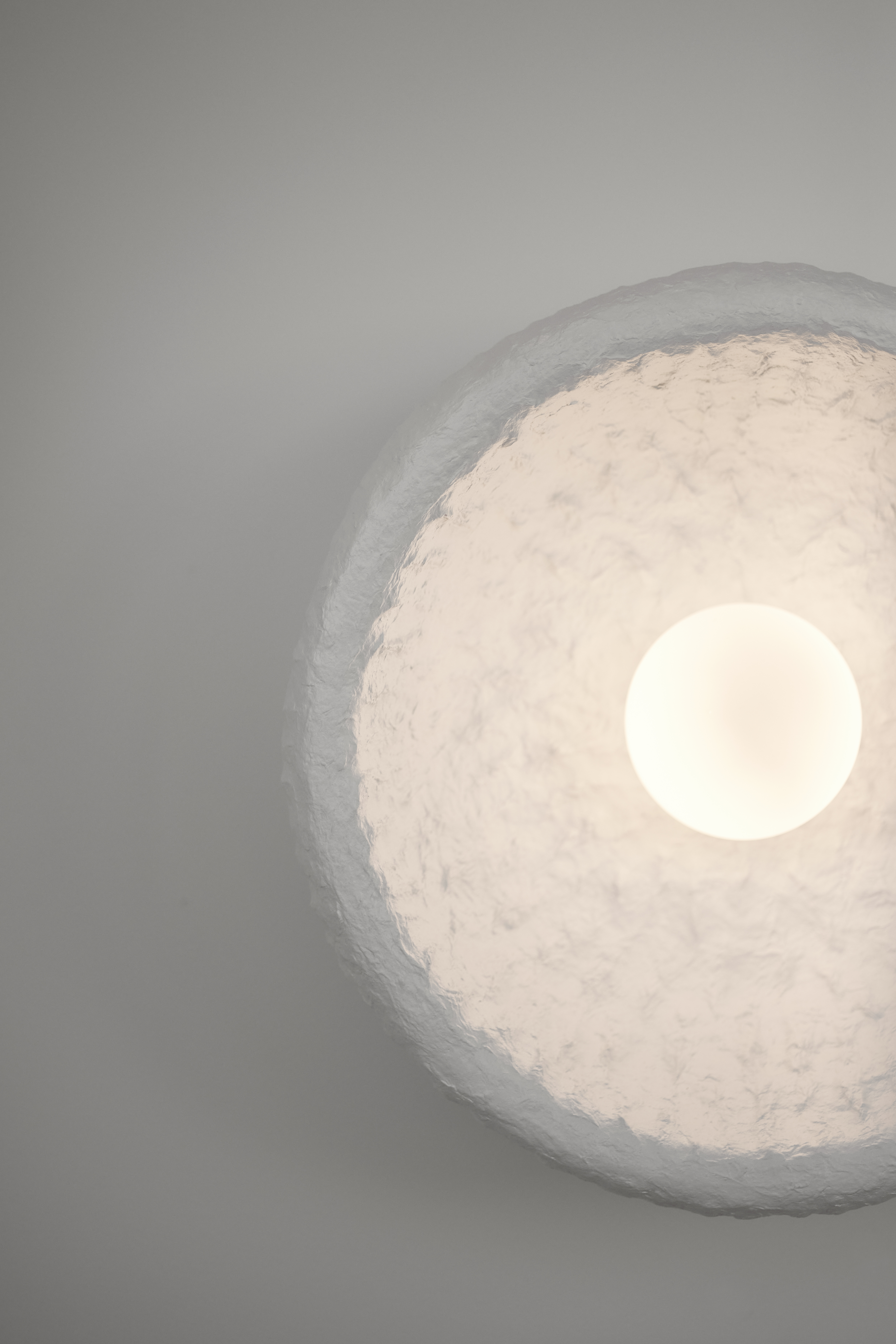Shaping a circular industrial ecosystem and supporting life-cycle thinking
SONIAH
{Empty}
The SONIAH collection reflects my vision of living in harmony with nature and embracing life in sync with solar rhythms. Rooted in sustainable, contemporary design, the collection draws on the timeless connection our ancestors shared with the natural elements: Earth, Sun, Water, and Air. The lamps, defined by their primitive yet sophisticated forms, embody the artistry of refined craftsmanship while taking inspiration from Ukraine’s sunflower fields.
Ukraine
National
It addresses urban-rural linkages
It refers to other types of transformations (soft investment)
Yes
2019-10-01
No
No
No
As an individual
The Soniah lamp is a testament to the principles of circular design and life-cycle thinking, crafted in Ukraine using locally sourced clay and a patented technique. This project catalyzes shaping a circular industrial ecosystem, as it combines sustainable production with a deep connection to Ukrainian cultural heritage. The lamp is crafted by skilled workers, providing meaningful employment and supporting the local workforce amid the ongoing war.
Inspired by the sunflower, a symbol of resilience, hope, and prosperity, the Soniah lamp embodies the strength of Ukraine, a nation that is one of the world’s leading exporters of sunflower oil. The lamp’s international recognition highlights Ukraine’s creative spirit, transforming the narrative from loss to renewal and showcasing the country’s resilience.
The key objectives of the project were to preserve Ukrainian cultural identity, create sustainable, locally sourced products, and offer employment opportunities while contributing to the country’s economic vitality. The Soniah lamp meets these objectives by employing a circular design approach, minimizing waste, and using eco-friendly materials. Through its innovative design and commitment to local production, it not only honours Ukraine’s rich heritage but also promotes a sustainable future.
Inspired by the sunflower, a symbol of resilience, hope, and prosperity, the Soniah lamp embodies the strength of Ukraine, a nation that is one of the world’s leading exporters of sunflower oil. The lamp’s international recognition highlights Ukraine’s creative spirit, transforming the narrative from loss to renewal and showcasing the country’s resilience.
The key objectives of the project were to preserve Ukrainian cultural identity, create sustainable, locally sourced products, and offer employment opportunities while contributing to the country’s economic vitality. The Soniah lamp meets these objectives by employing a circular design approach, minimizing waste, and using eco-friendly materials. Through its innovative design and commitment to local production, it not only honours Ukraine’s rich heritage but also promotes a sustainable future.
Innovation
Symbolism
Sustainability
Resilience
Cultural Heritage
The Soniah lamp exemplifies sustainability by utilizing eco-conscious materials, with the innovative ZTISTA material at its core. Drawing inspiration from "valkyvannya"—an ancient Ukrainian wall-finishing technique—the lamp incorporates a unique combination of upcycled steel, flax rubber, wood chips, cellulose, and clay, all encased in a biopolymer cover. By sourcing materials locally, the production process minimizes environmental impact. The lamp’s lightweight, durable design reflects a commitment to sustainability, with a timeless aesthetic that transcends trends.
The Soniah lamp is a prime example of biophilic design, seamlessly connecting users to nature through its organic shape and textured finish. The lamp's form, inspired by the silhouette of a sunflower, transforms it into a functional sculpture that evokes beauty, tranquility, and inspiration. This thoughtful design fosters a deeper connection to the natural world, enhancing the user experience.
By blending art with functionality, it not only provides illumination but also adds emotional warmth, transforming any space into a harmonious and uplifting environment. The lamp’s design, which celebrates both aesthetic beauty and cultural significance, offers a meaningful experience that exemplifies how design can enhance the quality of life and contribute to a deeper sense of well-being.
By blending art with functionality, it not only provides illumination but also adds emotional warmth, transforming any space into a harmonious and uplifting environment. The lamp’s design, which celebrates both aesthetic beauty and cultural significance, offers a meaningful experience that exemplifies how design can enhance the quality of life and contribute to a deeper sense of well-being.
The Soniah lamp embraces inclusivity by combining cultural significance with universal appeal. Its design is inspired by the sunflower (soniakh in Ukrainian), a powerful symbol of resilience, warmth, and hope. This cultural narrative not only makes Soniah a functional object but also an emotional and symbolic one, fostering a sense of connection across diverse audiences.
By incorporating design principles that resonate with people from various backgrounds, the Soniah lamp transcends cultural and geographical boundaries, creating a shared experience. Its universal appeal ensures that it can be appreciated by all, while its cultural roots celebrate and honor Ukrainian heritage. This project exemplifies how design can be both culturally inclusive and emotionally accessible, offering a meaningful experience that connects people on a deeper level.
By incorporating design principles that resonate with people from various backgrounds, the Soniah lamp transcends cultural and geographical boundaries, creating a shared experience. Its universal appeal ensures that it can be appreciated by all, while its cultural roots celebrate and honor Ukrainian heritage. This project exemplifies how design can be both culturally inclusive and emotionally accessible, offering a meaningful experience that connects people on a deeper level.
The Soniah lamp project is deeply rooted in the involvement of local citizens, whose work is essential to its creation. These individuals are not just manufacturers but active contributors to a larger cultural and economic movement. By using traditional techniques and locally sourced materials, they play a key role in preserving Ukraine’s artisanal heritage while ensuring that production remains sustainable and community-driven.
Beyond economic benefits, their involvement fosters a sense of pride and resilience, as each Soniah lamp carries a piece of their skill, history, and cultural identity.
This collaborative effort strengthens local communities while demonstrating the power of design as a force for social and economic stability. The impact extends beyond the workers themselves, as the Soniah lamp symbolizes not just craftsmanship but also the collective strength and spirit of the people behind it.
Beyond economic benefits, their involvement fosters a sense of pride and resilience, as each Soniah lamp carries a piece of their skill, history, and cultural identity.
This collaborative effort strengthens local communities while demonstrating the power of design as a force for social and economic stability. The impact extends beyond the workers themselves, as the Soniah lamp symbolizes not just craftsmanship but also the collective strength and spirit of the people behind it.
The Soniah lamp project was shaped by a diverse network of contributors whose expertise and involvement spanned multiple levels. At the local level, skilled workers and craftspeople played a crucial role in the hands-on production, ensuring that each lamp reflected traditional techniques and high-quality craftsmanship.
At a regional and national level, the project benefited from collaboration with material suppliers, logistical partners, and industry professionals who helped optimize production and distribution. This network ensured that the lamp’s sustainable materials were sourced responsibly and that its journey from workshop to customer remained efficient and environmentally conscious.
While the project was driven by a focused creative vision, the involvement of these stakeholders—both direct and indirect—added significant value. Their contributions strengthened the integrity of the process, enhanced the project's reach, and ensured that Soniah stands as a meaningful example of design that bridges tradition and modernity.
At a regional and national level, the project benefited from collaboration with material suppliers, logistical partners, and industry professionals who helped optimize production and distribution. This network ensured that the lamp’s sustainable materials were sourced responsibly and that its journey from workshop to customer remained efficient and environmentally conscious.
While the project was driven by a focused creative vision, the involvement of these stakeholders—both direct and indirect—added significant value. Their contributions strengthened the integrity of the process, enhanced the project's reach, and ensured that Soniah stands as a meaningful example of design that bridges tradition and modernity.
The design and implementation of the Soniah lamp brought together expertise from multiple disciplines, creating a collaborative process that ensured both aesthetic and functional excellence.
Traditional craftsmanship played a central role, with skilled workers shaping the lamp using time-honoured techniques that preserve Ukraine’s cultural heritage. Woodworking expertise was essential in constructing the internal wooden frame, providing a strong yet lightweight foundation for the lamp. Electrical work specialists ensured that the lighting components were safely integrated, making the Soniah both beautiful and functional. Finally, logistics professionals coordinated the transportation and distribution of the lamps.
The interaction between these disciplines created a seamless production process, where each expert contributed their unique knowledge to refine and enhance the final product. This cross-disciplinary collaboration not only strengthened the quality and durability of the Soniah lamp but also reinforced the project's core values—blending sustainability, craftsmanship, and innovation into a meaningful design piece.
Traditional craftsmanship played a central role, with skilled workers shaping the lamp using time-honoured techniques that preserve Ukraine’s cultural heritage. Woodworking expertise was essential in constructing the internal wooden frame, providing a strong yet lightweight foundation for the lamp. Electrical work specialists ensured that the lighting components were safely integrated, making the Soniah both beautiful and functional. Finally, logistics professionals coordinated the transportation and distribution of the lamps.
The interaction between these disciplines created a seamless production process, where each expert contributed their unique knowledge to refine and enhance the final product. This cross-disciplinary collaboration not only strengthened the quality and durability of the Soniah lamp but also reinforced the project's core values—blending sustainability, craftsmanship, and innovation into a meaningful design piece.
My project introduces an innovative approach compared to conventional practices in the furniture industry. When creating Soniah, I was among the first to develop a method of coating a base with a specialized mixture, making it suitable for both indoor and outdoor use. Unlike traditional upholstered furniture, wood, or compressed plastic, this approach utilizes a core—either wood or paper—that is then coated with a unique compound.
Before, this technique was rarely applied in furniture manufacturing. While similar concepts existed, they were primarily limited to art installations, collectible design, or experimental projects. I was the first to successfully transform this principle into a functional, durable, and scalable solution. By merging innovation, aesthetics, and practicality, we introduced a groundbreaking approach that has since influenced the industry.
Before, this technique was rarely applied in furniture manufacturing. While similar concepts existed, they were primarily limited to art installations, collectible design, or experimental projects. I was the first to successfully transform this principle into a functional, durable, and scalable solution. By merging innovation, aesthetics, and practicality, we introduced a groundbreaking approach that has since influenced the industry.
My project introduces an innovative methodology that merges functionality, aesthetics, and craftsmanship at scale. I was among the first to apply this principle in furniture design—not as an artistic experiment, but as a functional, mass-producible innovation.
At its core is a unique coating mixture of clay, cellulose, flax fibres, dried grasses, and fine wood shavings. Depending on the base, using organic and locally sourced materials ensures sustainability and potential recyclability.
The process starts with a solid base, typically wood, coated in multiple textured layers. Craftsmen’s fingerprints remain visible, adding a human touch and cultural dimension. This approach integrates technology, sustainability, and aesthetics, bridging innovation with heritage.
At its core is a unique coating mixture of clay, cellulose, flax fibres, dried grasses, and fine wood shavings. Depending on the base, using organic and locally sourced materials ensures sustainability and potential recyclability.
The process starts with a solid base, typically wood, coated in multiple textured layers. Craftsmen’s fingerprints remain visible, adding a human touch and cultural dimension. This approach integrates technology, sustainability, and aesthetics, bridging innovation with heritage.
My approach—applying a custom mixture onto a base to create functional and aesthetic pieces—has influenced the industry and can be adapted across various contexts. Developed in 2017, this technique has since gained traction.
The principle is highly versatile: it allows for the transformation of any object, from new designs to repurposed vintage furniture, making it both sustainable and customizable. By altering the composition of the mixture, creators can tailor the aesthetic and functional properties to different needs.
This concept has already integrated into global design trends, demonstrating its scalability and potential for further evolution.
The principle is highly versatile: it allows for the transformation of any object, from new designs to repurposed vintage furniture, making it both sustainable and customizable. By altering the composition of the mixture, creators can tailor the aesthetic and functional properties to different needs.
This concept has already integrated into global design trends, demonstrating its scalability and potential for further evolution.
The project addresses the global challenge of overproduction and waste by offering a sustainable, locally rooted solution. Mass production often leads to excessive resource consumption, environmental degradation, and disposable products that contribute to landfill overflow. In contrast, the Soniah lamp embraces a circular approach, using locally sourced, biodegradable materials that leave no lasting waste footprint.
The use of natural, non-toxic materials aligns with global efforts to combat pollution and promote sustainable design.
In a world where fast consumption dominates, Soniah demonstrates how thoughtful, small-scale production can offer a viable alternative—one that values longevity, craftsmanship, and ecological responsibility. This model can serve as an inspiration for other industries looking to balance sustainability with cultural and economic resilience.
The use of natural, non-toxic materials aligns with global efforts to combat pollution and promote sustainable design.
In a world where fast consumption dominates, Soniah demonstrates how thoughtful, small-scale production can offer a viable alternative—one that values longevity, craftsmanship, and ecological responsibility. This model can serve as an inspiration for other industries looking to balance sustainability with cultural and economic resilience.
My project addresses both economic and psychological challenges by providing sustainable local solutions. It creates job opportunities, particularly for women, offering not only financial stability but also a sense of purpose and connection. The manual, detail-oriented nature of the work has a grounding, therapeutic effect, helping workers find balance and creative fulfilment.
In the context of war, where stress and uncertainty are overwhelming, this work serves as both employment and art therapy. It fosters resilience, community, and a connection to something meaningful. By combining craftsmanship with economic support, the project contributes to individual well-being and broader societal stability.
In the context of war, where stress and uncertainty are overwhelming, this work serves as both employment and art therapy. It fosters resilience, community, and a connection to something meaningful. By combining craftsmanship with economic support, the project contributes to individual well-being and broader societal stability.






